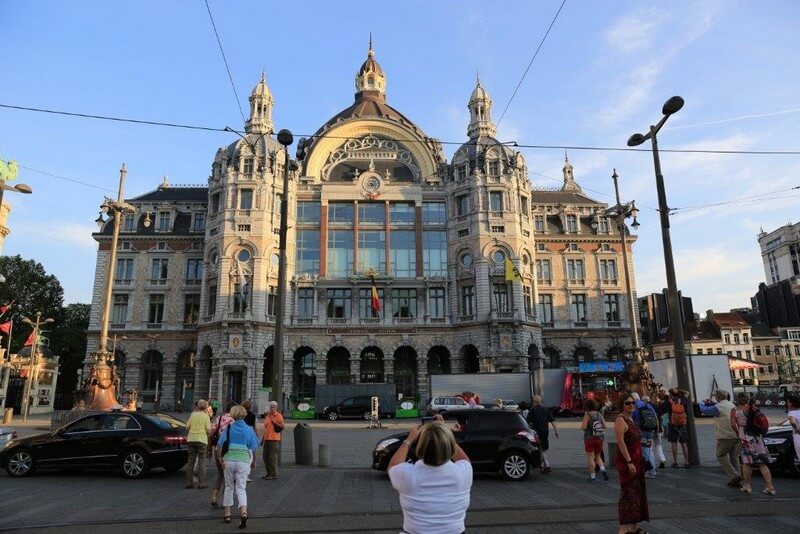Sometimes Belgium gets overlooked as a prime vacation destination—crowded out by its more flamboyant sisters like France, Italy, and Germany. But Belgium is a fabulous place to visit; it’s got history, culture, architecture, and cuisine, not to mention gorgeous natural landscapes just begging to be explored on a bicycle.
So if you’re looking for someplace different for your travels this year, here are 14 reasons to put Belgium on your short list.
See all Belgium tours
1. Belgian beer—need we say more?
It’s not really an overstatement to say there’s a bit of a cult following when it comes to Belgian beer. Let’s start with the Trappist influence; did you know there are just 11 Trappist monasteries in the world producing beer and six of them are in Belgium?
Of course, you don’t need to worship the Trappists to enjoy Belgian craft beer—the country produces about 1,500 of them with varying sweet, spicy, fruity, and bitter overtones. Bruges, in particular, has beer running through its veins. Beer lovers, do yourself a favor and visit Belgium!

2. Get to know the “Flemish Primitives” at the impressive museums in Bruges.
In the 15th and 16th centuries, cities like Antwerp, Ghent, Brussels, and Bruges were at the heart of a major art movement by masters such as van Eyck, van der Weyden, and Memling. Collectively known as the “Flemish Primitives,” they took the new medium of oil painting to a whole new level of detail.
At the Groeningemuseum in Bruges, you can see one of the finest collections of “Flemish Primitives” in the world—definitely worth a visit.
3. If you’re looking for romance, you’ll find it in Bruges.
Move over, Venice — Bruges is a city for lovers. Picture yourself strolling through verdant fields of daffodils at the Beguinage or watching the boats and swans float by from your perch on the “Bridge of Love.”
Legend has it that if you and your lover cross the Minnewater Bridge, your love will never die. In the story, young Mina was in love with a warrior named Stromberg, but her father forced her to marry another man. She ran to the woods to escape her fate and died there of exhaustion.
When Stromberg returned from his battles, he dammed a stream so that water would forever run over her grave. The Minnewater Bridge and the Lake of Love are the result of his efforts.

4. Forget Paris! Ghent is the city for conscious foodies.
Did you know that Ghent is the European vegetarian capital, known for its incredible chefs creating world-glass meat-free cuisine for its health-conscious citizens?
In fact, Ghent has so embraced its reputation as the veggie capital of Europe, it even instituted Thursday Veggie Day to encourage everyone to go meat-free at least one day a week.
If you’re into a healthy vegetarian diet, you won’t have to settle for bland veggie dishes in Ghent—you’ll get world-class cuisine by some of the most creative chefs in Europe.

5. See the “world’s most coveted painting.”
Van Eyck’s The Adoration of the Mystic Lamb, also known as the Ghent Altarpiece, was completed in 1432, and it’s “arguably the single most important painting ever made.” That may be the reason it’s also one of the most stolen works of art in history. Starting in 1566 when Protestant militants stole the giant masterpiece and ending some six centuries later in 1934 when thieves made off with one of the panels, the work hasn’t been completely reunited in one place.
You can see (most of) the painting at the St. Bavo Cathedral in Ghent — but the stolen lower left panel has been replaced with a copy. The mystery of the missing piece still hasn’t been resolved.

6. You really want to know the story of Charlemagne and the Bayard Steed in Dendermonde.
For years, Lord Aymon of Dendermonde and his four sons feuded with their lord Charlemagne. Lord Aymon’s sons continued the fight for years, riding their loyal horse, Ros Beiaard, who was rumored to be so massive all four sons could ride him at once.
According to the medieval chanson de geste Quatre Fils Aymon, Charlemagne demands the horse as the price of peace to end the feud. He ties a stone to the horse’s neck and has him pushed into the river to drown, but the horse smashes the stone with his mighty hooves and escapes to the woods.
Every 10 years, the city of Dendermonde celebrates the Bayard Steed with a festival and parade. Although the next parade isn’t until 2020, you can immerse yourself in medieval folklore in this lovely town, and enjoy a cup of coffee at the old Grote Markt.

7. The River Scheldt is so beautiful, van Rysselberghe couldn’t stop painting it.
If you’re lucky enough to ride your bike along the River Scheldt, you’ll understand why the Belgian neo-impressionist painter Theo van Rysselberghe painted it so many times. It’s landscapes are so lovely, Bobbejaan Schoepen even wrote a song about it.
The dykes of the Scheldt make for beautiful cycling—there are some 570 kilometers of bike paths along the river on the way to Antwerp.

8. The castles and medieval architecture are lovely, but have you seen the incredible modern architecture in Ghent?
From the incredible Liege-Guillemins railway station to the magnificent MAS “museum by the stream,” Ghent’s architectural marvels are a feast for the eyes.
Of course, if medieval castles are more your thing, you shouldn’t miss a trip to the Castle of the Count, a massive edifice that embodies the heraldic culture of the 12th century.

9. Love caffeine? Antwerp has the largest stockpile of coffee beans in the world.
After a full day of cycling through Belgium, a great cup of coffee is the perfect pick-me-up. And there’s no better place to find it than Antwerp, where over 250,000 tons of coffee beans are stored at the Port of Antwerp. That’s enough to make some 27 billion cups of coffee!
And the people of Antwerp are proud of their port and coffee abundance—you can visit a coffee roasting house in virtually every neighborhood and plenty of charming squares in which to savor your cup of joe.

10. Move over, Milan. Antwerp is a fashion powerhouse.
You may not think haute couture when you think of Belgium, but some are calling Antwerp the 5th fashion capital of the world. There’s even a museum, MoMu, that celebrates the city’s contributions to high fashion.
But don’t think it’s all about clothes—Antwerp is also the place to shop for exquisite diamonds and jewelry. If you want to make a huge romantic statement, imagine buying your love a stone from the oldest diamond center in Europe? Antwerp’s diamond history dates back to the 15th century, and today, you can find amazing diamond boutiques around Vestingstraat and the Lange Herentalsestraat near Central Station.

11. Have you ever seen a flower carpet made of one million begonias?
Belgium is the begonia capital of the world—60 million bulbs, equaling 80% of the world’s production, are cultivated in the countryside around Ghent. To celebrate the country’s begonia supremacy, the city of Brussels has been creating a flower carpet each year since the early 1970s.
Known as the Flower Carpet of Belgium, this floral spectacle is on display once a year, usually around the 15th of August. It’s made of between 600,000 and 1,000,000 begonia plants carefully arranged in intricate patterns near the city’s Grand-Place. If you’re planning to bicycle Belgium this year, don’t miss the amazing display.

12. Calling all history buffs: Do you want to see Waterloo?
The notorious reign of Napoleon Bonaparte came to an end at the Battle of Waterloo just outside Brussels. Napoleon’s surrender to the Duke of Wellington marked a turning point in European history.
History buffs can visit the famous Champ de Bataille where over 250,000 men fought (and 11,000 died) in the bloodiest battle prior to the 20th century.
13. Everyone needs a selfie with Manneken Pis and his sidekicks Jeanneke and Zinneke.
The peeing statue of Brussels is a celebrated mascot—he’s even received gifts from kings! No one really knows his true origins, but he’s been a fixture in Belgian history since the mid 15th century.
After 500 years as the reigning “peeing statue,” Manneken Pis now has two peeing sidekicks, the peeing girl Jeanneke, found on Rue des Bouchers, and the peeing dog Zinneke, located on Rue de Chartreux. You know you want a selfie with this famous Brussels icons.

14. Finally, let’s not forget Belgian chocolate.
Belgium was making chocolate long before most other countries had even figured out what cocoa beans were. It was the first country to engineer chocolate-making machines to create smooth, velvety chocolates — which is probably how they pioneered the praline, a chocolate shell filled with nougats and creams.
Belgian chocolate culture is a matter of local pride, which is why you can find amazing chocolate shops on the streets of Bruges, Antwerp, Brussels, and Ghent. If you like chocolate, you’re going to love Belgian chocolate.

Ready to see Belgium?
See why we love Belgium so much? If you’re thinking of a boat and bicycle tour this year, why not get in touch today to find out more about why Belgium is the perfect destination. We’ve got some great tours lined up and you won’t want to miss out. Not ready to plan your trip just yet? Sign up for our free email course to learn more about planning a bicycle and boat vacation.
Plan your trip


